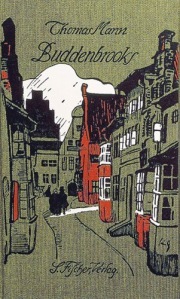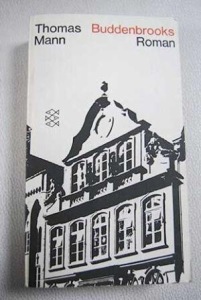
I have always wanted to offer Buddenbrooks as a readalong during German Literature Month (GLM) but a number of regular GLM participants have already read it on their own. After visiting the Buddenbrooks house in Lübeck last June, this was always going to be the year for, what I think is, my 5th reread. When I discovered that Tony Malone of Tony’s Reading List was also in the midst of a reread, I suggested that we have a leisurely chat about it. So we did just that – on and off for about a fortnight! We’ve ended up with a thesis enough material to a) do the author justice, and b) dedicate a long weekend to the novel William Faulkner considered the best novel of the twentieth century. This is a four-part conversation that consists of:
Part One – Background, Business and Buildings (Published below)
Part Two – Character flaws in the 3rd and 4th generations (Published at Tony’s Reading List)
Part Three – On technique and the translation of dialects (Published at Tony’s Reading List)
Part Four – A 20th century novel in 19th century clothing
We hope you enjoy reading our ruminations as much as we did ruminating! Beware, there may be spoilers. If you’ve already read the novel, please add to the discussion.
Without further ado:
Part One – Background, Business and Buildings
TM: Which edition did you read, Lizzy?
LS: I read my beloved Folio Society edition which uses Helen Porter-Lowe’s translation. I know it’s fashionable to malign her work these days, as she was not always accurate, omitted sentences that could offend the finer feelings of her readership, and openly admitted that the translation of dialect was an impossibility! However, she did work with Thomas Mann’s blessing and I have to say that none of the above interfered with my enjoyment in any way. In fact, I found the old-fashioned and polite cadence of her style well-suited to the 19th century Hanseatic environment.
I assume you read the original, Tony. How did you get on and what motivated your reread?
TM: Yes, I was lucky enough to read it in the original German, and other languages besides (more on that later…), and my lovely Fischer Verlag edition even has a rather familiar photo on the front cover – of the famous Buddenbrook house! As for the reasons for my reread, well, I’m not sure there were any, really, apart from the fact that I’d been wanting to give it another go for a while. I think I was looking for something long and comforting at the time, and while Anthony Trollope is usually my go-to author in that category, there was something about another vicarious journey to Lübeck that appealed… I’d have to say that the setting was a major attraction; with Husum (Theodor Storm’s old stomping ground) not far away, this area of Germany has quite the literary history – as you recently found out!
LS: I did. It was all rather wonderful, if a tad wet! It appears all the bad weather blows over from Scotland to Schleswig-Holstein! (Or it did in June, when I was there.) But I digress. You wanted something long and comforting. Long it certainly is. Comforting? I suppose it is, in the sense of being familiar (although I was surprised by how much I had forgotten!) On the other hand the history of the Buddenbrooks isn’t exactly a happy one; the novel is subtitled Verfall einer Familie (decline of a family.) When do you think the decline sets in?
TM: To be honest, I think it’s already begun to some extent when the novel begins. The purchase of the new house is symptomatic of the family’s desire to show off their status (ironically enough, no different to the way other, ‘lower’, families seek to prove themselves later), and it’s this willingness to sink their hard-earned capital into bricks and mortar, which appears to be a depreciating asset in this period, that brings about their decline. You could argue that the later purchase of a bigger house is the moment that tips them over the edge, but for me the seeds of the family’s decline are there from the very first page…
Speaking of the era, I think the time and place are a crucial aspect of the story as it is often external influences that affect the family’s fortunes. Did you know a lot about the period before reading the book?
LS: Not in any great detail and I found it didn’t really matter as there is sufficient exposition in the text. Business is business in whichever era, rivalries will always exist and the nouveau-riche blamed for the malaise of the more established families. (I loved how Antonie (henceforth Tony) made such a bête-noire of the Hagenströms, even though the Buddenbrooks don’t go that far back themselves. After all, Tony is only 3rd generation herself.
 That said, Mann places the novel firmly in the context of 19th century Lübeck, a city granted independent free status in 1815, and able to profit from its advantageous waterway connections from the river Trave to the Elbe and the Baltic Sea to trade grain. That is the source of the Buddenbrooks fortune and also the reason for the big mercantile house, the ground floor of which would have served as business premises. If you look at the Fischer Verlag book cover, you can see the layout of the house. The large ground floor, business premises and at time storage facilities, the lst floor where the family lived, and the second floor with smaller windows for bedrooms and servants quarters,
That said, Mann places the novel firmly in the context of 19th century Lübeck, a city granted independent free status in 1815, and able to profit from its advantageous waterway connections from the river Trave to the Elbe and the Baltic Sea to trade grain. That is the source of the Buddenbrooks fortune and also the reason for the big mercantile house, the ground floor of which would have served as business premises. If you look at the Fischer Verlag book cover, you can see the layout of the house. The large ground floor, business premises and at time storage facilities, the lst floor where the family lived, and the second floor with smaller windows for bedrooms and servants quarters,
Apropos the business, Mann incorporates fastidious details of grain transaction and prices into the text, but I glossed over these to be honest, It was sufficient to know that Thomas Buddenbrooks lacked the business acumen of his grandfather and father, despite his promising start, best efforts and ongoing exertions. I found all the shenanigans and details concerning Tony’s and Erika’s dowries much more interesting! It wasn’t only bad business that frittered away the family fortune. It’s a puzzle to me that the Buddenbrooks couldn’t find suitable marriage partners for their women. Can you offer any explanations?
TM: (Response to be revealed tomorrow.)
A fascinating discussion of a book I read, and adored, for German Lit Month several years ago. Will stay tuned to your discussion with Tony, as you both will probably unearth things that never occurred to me. 😉
Wonderful discussion of a work I read last year. Just now I watched a very good documentary on Thomas Mann, about 45 minutes, it goes into a lot of family detail, relating his life to Buddenbrook, deals very openly with his strong homoertotic feelings, the numerous family suicides, all done very respectfully and well illustrated
Thanks, Mel. Will watch. Will be interesting to see if it agrees with some of the points Tony and I make later in our discussion ….
Let me know, please, your reaction.
I loved how Mann enters into the minds of his characters using the sort of affective techniques of Flaubert (i.e. exposition and setting descriptions, including leitmotifs, also convey character attitudes) which gives us romantic Tony (who’s speaks from wisdom and experience! so much has happened to her! she knows all about it, and won’t shut up about it) and so the characters feel like real people. I like to say Mann is like Flaubert in technique but his opposite in attitude: Flaubert finds the Bovarys absurd, while Mann loves all his character, even Tony, in spite of their absurdities.
A signal moment for the general technique is at the beginning where the doctor gives a rosy prognosis to the family, then the narrator shifts perspective suddenly and we get the actual, grim prognosis.
Well, hello @bookappreciator. Welcome to the blog and thanks for that comment. I haven’t read Flaubert since my French A-level, amd I never thought I would return to him. But the Peter Gay book mentioned in part four of the Buddenbrooks conversation has an essay on Madame Bovary that was tempting me to revisit. Your comment about (dis)similarities with Mann has sealed the deal!
That’s certainly putting me in the mood to read this finally.
Really? And here I am assuming every German-speaking reader will have read this at least once ….